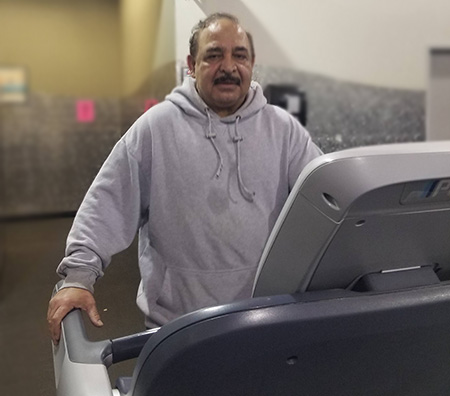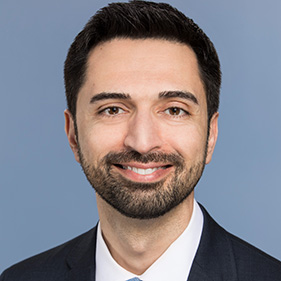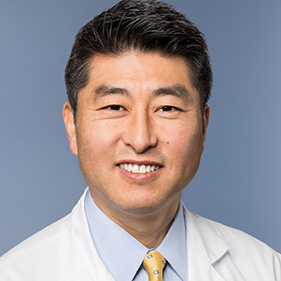UC Davis Health offers first comprehensive robotic neurosurgery program in the region
‘I imagine a robot is much more accurate than a human’: Stroke patient shares his robotic surgery experience
One day in early 2022, as Haytham Almunir got into his friend’s car to join him for lunch, he noticed the fingers on one of his hands suddenly stiffened and stuck together. He separated them with the other hand, but they immediately stuck back together.
As his friend drove, he asked Almunir questions. Almunir noticed he couldn’t find the words to respond.
“My friend was asking me questions, but I couldn’t answer. When no words were coming, I got really scared,” he said.
This lasted for about 30 minutes. When they arrived at the restaurant, Almunir’s friend gave him five aspirins, thinking it was a stroke. Almunir’s body slowly returned to normal. But something was still off — his lunch didn’t taste good at all. His friend urged him to go to the hospital.
Almunir agreed and drove himself to UC Davis Medical Center, where emergency department imaging confirmed he’d had a stroke. Almunir was grateful to have recovered this time — and he wanted to do everything he could to reduce his risk of future strokes.
Almunir soon met UC Davis endovascular neurosurgeon Ben Waldau, who shared that Almunir was experiencing a carotid stenosis, which is a tight artery in the neck. It was preventing sufficient blood flow to the brain. Waldau explained that Almunir had two options: an open plaque removal from his artery, or placement of a stent in his artery to hold it open. Almunir chose the stent.

His stent was the first at UC Davis to be placed by a new endovascular robot. Surgeons used the robot to navigate an extremely thin wire past the constriction in his artery and open the artery with a balloon just wide enough to place the stent. They then exited the artery and removed the balloon without disturbing the stent.
“My first thought was ‘that’s cool.’ I imagine a robot is much more accurate than a human,” Almunir said. “Once I knew about the robot, I felt even more confident in the quality of my surgical care.”
The region’s most comprehensive robotic neurosurgery program
In November 2022, UC Davis Health added a robot for cranial procedures such as deep brain stimulation implants, used for conditions such as Parkinson’s disease. Robots were already in use for spinal surgeries and for endovascular procedures like Almunir’s. Now, the health system is the first to offer a comprehensive robotic neurosurgery program in the region.
Surgeons are incorporating these tools across the spectrum of neurosurgical procedures for adults, children, and even developing babies.
Surgical robots are often used across specialties and drive interdisciplinary care, research and education. For example, the endovascular robot and surgical services are a joint venture of the Departments of Neurological Surgery and Radiology. The spine robot supports the UC Davis Spine Center, led by Neurological Surgery, Orthopaedic Surgery, Physical Medicine and Rehabilitation, and Pain Medicine.
“It’s important to know that robotic neurosurgery doesn’t mean there is a human-like robot in the room, working on its own,” said Kia Shahlaie, professor and interim chair of neurological surgery. “These are robotic arms. They allow us as surgeons to do things in a very delicate manner. They are fully controlled by our surgeons and staff, who are actively involved in all elements of the procedure.”
Robotic neurosurgery doesn’t mean there is a human-like robot in the room, working on its own. These are robotic arms. They allow us as surgeons to do things in a very delicate manner. They are fully controlled by our surgeons and staff, who are actively involved in all elements of the procedure.” —Kia Shahlaie, professor and interim chair of neurological surgery
Robots increase patient safety, decrease wait times
This technological teamwork increases patient safety and shortens procedure times and wait times. “We are getting faster and faster as we maintain higher accuracy,” Waldau said, noting that for one endovascular procedure the time has been cut in half.
More accurate, minimally invasive techniques lead to better spinal surgery outcomes, too.

“When we operate on spine patients, we worry about what will happen to adjacent vertebrae. For example, when you fuse one part of the spine, this puts more stress on nearby vertebrae that can cause future problems that require further treatment,” explained Kee Kim, chief of spinal neurosurgery and co-director of the UC Davis Spine Center.
He says robotic surgery reduces the chance that patients will return in the future with additional problems.
“Robots are the next evolution of providing better patient care — and at the foremost of this is improved patient safety,” Kim said.
Robots are the next evolution of providing better patient care — and at the foremost of this is improved patient safety.” —Kee Kim, chief of spinal neurosurgery
Robots support the UC Davis educational mission
Waldau finds the endovascular robot very easy to navigate, which makes it a good fit for neurosurgery residents learning in real time. “For most residents who grew up playing video games,” he said, “navigating the robot is a very natural next step, and they are quite talented at it.”

UC Davis Health offers comprehensive education in robotic-assisted neurosurgery to residents in this field.
“Our medical students and residents see robotic equipment helping patients early in their educations as doctors,” Shahlaie said. He sees the impact this has. “There are few opportunities each of us has in our lifetime to make another person’s life dramatically better. Within a few hours, to be able to give someone new meaning to life, to give them the opportunity to change their goals, plans and expectations for the rest of their life is an amazing honor.”
In Almunir’s case, the robotic surgery ensured he’ll have the health he needs to enjoy life—including many more lunches with his friend. During his stent procedure he received conscious sedation, which means at times he was awake. “There was a moment when I called Dr. Waldau’s name. He was right there. I couldn’t see his face, but he comforted me right away. This made me feel safe.”
Almunir is delighted with his treatment outcomes. “I go to the gym and jog,” he said. “I’m feeling great.”





